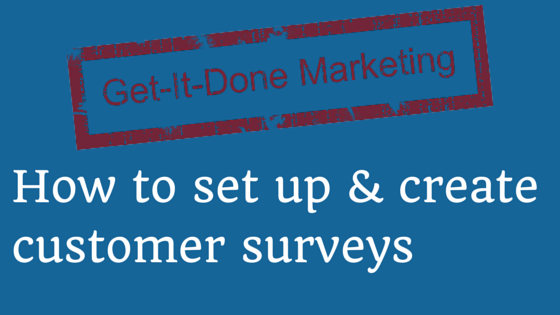When was the last time you asked your subscribers or clients what they wanted help with?
It’s easy to feel you know what your audience wants, especially if you’ve been in your business for a few years or more. But we live a fast paced life today and fashions, trends, technology and buying habits change far more regularly than ever before.
For example, just think how big an impact our smartphones have had on you over the past couple of years; those handy little computers in our back pockets have enabled even the least tech-savyy people to spend money whilst laying in bed or even waiting for a train.
Market research was traditionally seen as something fit only for big corporate budgets. But the tools available to you today make even the more in depth of surveys to be done with minimal effort, fuss or money. And this is what I wanted to share with you today.
Surveys have always been a critical part of my own marketing. As my own business has evolved and adapted over the years, so have the clients that I’ve attracted.
And I can pretty much guarantee that this will have happened to you too.
That is, if you have been paying attention to your market!

Why are surveys critical to your marketing?
If you assume, you make an ass out of me and you. I’m sure you’ll remember that from your school days if your science teacher as anything like mine!
A lot of business owners I speak to also have the predicament of focusing on clients “just like me”. It’s a common pattern because the service or products you were drawn to, often had an impact on you first.
For example, the personal trainer who discovered running and a new way of eating because of a health scare she had back in her corporate job. She remembers how much stress and the long commuting hours affected her health and she sees hundreds of people “just like me” at the local train station each morning as she runs past with her next, new client.
When you are your target client, it’s even easier to make those asses out of you and me. You run the danger of getting emotionally attached to your marketing and are often left scratching your head over another programme that you can’t quite fill.
The other reason why surveys are critical to your marketing is it gives you a jolly good reason to reach out to your database. And in a non-salesy way.
Surveys not only give you up to date intel on what your potential clients want from you, they can also create opportunities for those people to step forward and show some interest to what it is you are offering.
So if you feel you can only send out emails or messages with a some kind of promotion, think again!
What makes a good survey?
There are a few points I want to make here but first I want to highlight the fact that a survey is not just a one-chance request. If you can take the pressure of yourself from trying to create the “perfect survey”, you will realise that you can keep asking for opinions and feedback almost every week.
Most people love to express their opinions. And because so few businesses actually ask their customers for their thoughts and ideas, a survey is really quite a refreshing approach.
If you don’t get the results you were expecting from one survey, don’t be put off. You’ve got the next month to try a different approach. And the next month. And the next month.
So, what does make a good survey?
- Start with the end in mind. What are you trying to achieve? Is it a new product range you want to launch? Or are you stuck for ideas for your blog? Or are you concerned about the lack of leads or sales you are making? If you start with the problem that you are trying to solve, this will help keep you focused on asking the right questions.
- Short and sweet. Most people are busy; and probably way too busy to fill in a 5 page questionnaire. The less questions you ask, the more likely you will get a completed survey. Test your market place but if you want to start somewhere, I recommend no more than 3 or 4 questions.
- Start with your most important question first. If the drop rate is going to be 50% or more, then make sure you get the info that’s most important to you right up front.
- Anonymity. I would also recommend you leave asking for name and contact details to the very end. And never make it compulsory. If you force your person to enter their contact details first, there’s every chance you will experience very low response rates.
- Keep it simple. I’m going to recommend some survey tech below, but the easiest and simplest survey is asking people to answer a question by reply of email. This is actually a great way to start and a good habit to get into; especially if you make this part of your welcome autoresponder sequence when someone signs up on your website.
- Open questions work. Henry Ford was famously quoted as saying “If I had asked people what they wanted, they would have said faster horses.” If your aim to find out what people want help with ask a question such “What’s the #1 challenge you are facing right now?” The responses you get from such an open question will open up all sort of possibilities and avoid any assumptions on your part.
- Radio options work, too. To help people along a survey that may contain 3 or 4 questions, offering a multiple choice question helps speed up the process as well as builds confidence with the person answering your survey. The answers will help you segment your database, too so if it’s useful to ask if they are a man or woman, do it. Think of how this will help tailor your messages in the future by simply knowing the gender mix of your database!
- (Almost!) never ask about budget. I’ve put the caveat of (Almost!) because knowing how much someone has to spend is relevant at times (it’s a great way of self-selecting certain clients, for example). However, asking someone what they would pay for a workshop or online programme before they’ve truly understood the benefits and impact it would have on them and you will always get a cheaper answer than they will end up paying. Focus your questions on finding the pains and the problems. And then you can come with the right solution at the right price.
The important thing is that you start somewhere. And although there is a science behind market research and a huge industry that has grown up over the decades, a simple survey does not need a lot of time, energy or effort from you to put together. Especially as there are plenty of easy to use digital tools that make the whole process simple, efficient and painless.
How to create your survey
Here are some of my favourites:
- Google Forms. Free to use with a google account, you can create a survey in a matter a minutes from open text fields and radio buttons. You get a specific link to send people to the online form and each answer, once submitted, is automatically added to a Google Sheet for you analyse to your heart’s content.
- Survey Gizmo. $15 a month – if you commit within your 7 day trial – this web based tool gives you the ability to create simple through to fancy smancy. And yes, I do recommend you stick to simple!
- Poll Daddy. A little pricier but if your target client appreciates sliding scales and a slightly more tech or sophisticated feel, this is a great tool to try out.
- Zapier. This is not a survey tool but a handy web based service that syncs up your survey results with your email list (as well as dozens of other syncs & automated actions from one platform to another). So if you want to segment your database based on the answers for the survey, this is a great way of automatically integrating the info with your contact records without any manual click-and-pasting.
What to do with your survey responses once they arrive?
This does depend on how many responses you have to collect. A few dozen, which is probably a good number for most of you reading this,, will give you plenty of info to help you help your clients better.
What to do with the survey results?
Here’s what you can do with the info:
- Look for trends. This will need you, or another human being who knows your business rather than a piece of software, to go through the answers and look for patterns and groupings. You will find there will random answers that don’t fit in. But remember, you are looking to serve the majority, rather get side tracked by a random answer that may be just too niched.
- Follow up with people who have left their name and contact details. People who leave their name want to be heard. And our probably more likely to be interested in spending money with you at some point than the anonymous answers. This is not your opportunity to get your sales pitch out … but following up with a phone call to ask them to expand on their answers could mean that you are sitting on a goldmine of leads.
- Copy phrases. The words and phrases that are used in your survey responses are another goldmine. Use them in your marketing copy, in your headlines, your email subject headings, social media updates. The more in tune you can be with how your potential clients describe their problems and the solutions they are looking for, the easier it will be for them to clearly understand what it is you can help them with.
- Publish the results. If it’s relevant to your marketplace, publishing the results can lead to great marketing opportunities. Could you create a white paper or research paper? Is this something your local or trade press would be interested in? At the very least, your subscribers and clients would be interested and it’s a nice way of saying “thank you – we’ve listened”.
OK. Over to you. What are you going to do with this info? Has it inspired you to send out a survey to your subscribers? Perhaps it’s given you a golden marketing opportunity and saved you from another hellish promotional campaign that was destined to fail!
I would love to know what you think about surveys so leave a comment below.
Plus, I would also love hear from you about how I can help you, too. My most recent survey is right here and it would be wonderful to find out your answers to my questions. It may even give you some inspiration on what to ask in yours, too!






